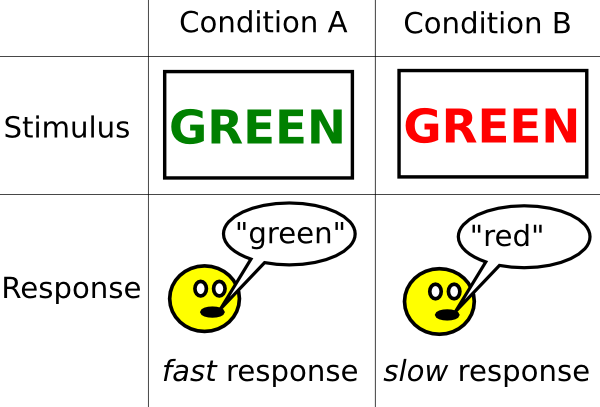Introduction
The Stroop effect is one of the best known phenomena in cognitive psychology. The Stroop effect occurs when people do the Stroop task, which is explained and demonstrated in detail in this lesson. The Stroop effect is related to selective attention, which is the ability to respond to certain environmental stimuli while ignoring others.
The Stroop task
In the Stroop task, people simply look at color words, such as the words "blue", "red", or "green". The interesting thing is that the task is to name the color of the ink the words are printed in, while fully ignoring the actual word meaning. It turns out that this is quite difficult, and you can find out exactly how difficult this is below.
It is very easy to name the color of the word "black" when it is printed in black (most text is written in black ink). It is also very easy to name the color of the word "red" printed in red ink color.
It is difficult, though, when the word and the ink color are different! This extent of this difficulty is what we call the Stroop effect.
| Even though it was developed in the 1930s, the Stroop task is still frequently used in cognitive psychological laboratories to measure how well people can do something that clashes with their typical response pattern. This task requires a certain level of "mental control". That is, you need to be aware of the task you are doing now and ignore how you would normally respond to words. This requires "control" over your own default cognitive processing. |
The Stroop effect
As you now understand, the Stroop effect is the degree of difficulty people have with naming the color of the ink rather than the word itself. In Stroop’s words, there is so-called "interference" between the color of the ink and the word meaning. This interference occurs no matter how hard you try, which means that it is uncontrollable with the best conscious effort. It implies that at least part of our information processing occurs automatically. It happens, whether you want it or not! Do you think this is true? If you think it is not true, how can you test this? Could you argue that if you train yourself long enough, you would no longer show the Stroop effect?
| In Stroop’s original study, there were three different experiments, and they were slightly different from the demonstration below. This is mainly for practical reasons. That is, it is easier to measure the exact time a button press takes place than to measure when people start saying a word using voice-key technology. |
In pictures
In the original study by Stroop, people were shown a list of words printed in different colors. They were asked to name the ink color, and to ignore the meaning of the word. It turned out that people were slower and made more mistakes when there was a clash between the word meaning and the ink color (e.g., the word "green" in red ink color).

Why is the effect interesting?
This effect is quite surprising. The task is surpringly more difficult than you would think when you just read about the Stroop task. Something that is surprising is interesting, because it forces you to think: Hey, why is this happening? It is not as easy as I had expected!
One of the explanations for the difficulty is that we are so used to processing word meaning while ignoring the physical features of words, that it is a learned response. The Stroop task requires us to do something which we have never learned and which is opposite what we normally do. MacLeod’s 1991 paper is still an excellent overview of about the Stroop task (although already more than 2 decades old).
Do it yourself
| In this example, you will see colored words (like GREEN, or BLUE). You need to respond to the color of the words (not the meaning) by pressing the corresponding key (r,g,b,y for red, green, blue, and yellow stimuli). |
Ideas for home work
-
Which colors did Stroop use in his experiments? Why?
-
Read the description of the original experiments and describe how they differed from the current experiment.
-
Give at least three examples of automatic visual processing in daily life.
-
Do you get better at the task with training? Does your Stroop effect get smaller? Can you get rid of it altogether with training?
-
What would happen if the task is carried out by someone who does not know any English?
| Do you want to understand how to create an experiment like this yourself? Check out this tutorial on how this code works line by line. |
Translate into your own language
Watch this video how to do this.
Test if you understood this lesson
If you can answer the questions below, you have a good grasp of the lessons.
Easy questions:
-
Question: What is the Stroop effect?
-
Question: Why is it called the "Stroop" effect?
More difficult questions:
-
Question: What is "interference"?
-
Question: In what sort of units is the Stroop effect measured?
-
Question: Does it matter what colors are used in the Stroop task?
-
Question: A German with no knowledge does the English Stroop task, what would happen?
Very difficult questions:
-
Question: Why do we use the same stimuli over and over?
-
Question: Would it be possible to overcome the Stroop effect with enough training?
Reading material
-
Stroop, J.R. (1935). Studies of interference in serial verbal reactions. Journal of Experimental Psychology, 18, 643-662. Read this original paper online.
-
MacLeod, C. M. (1991). Half a century of research on the Stroop: An integrative review. Psychological Bulletin, 109, 163-203.

